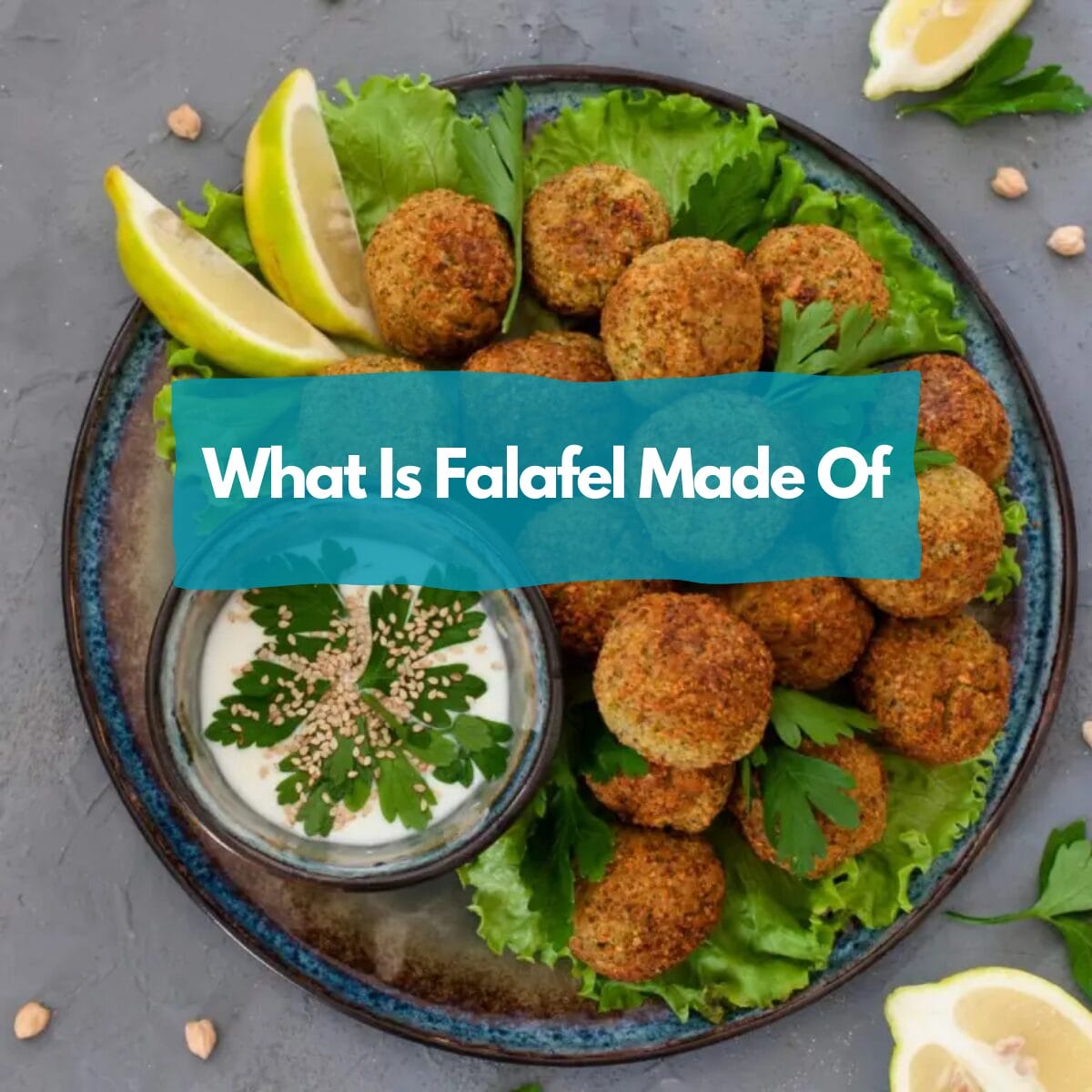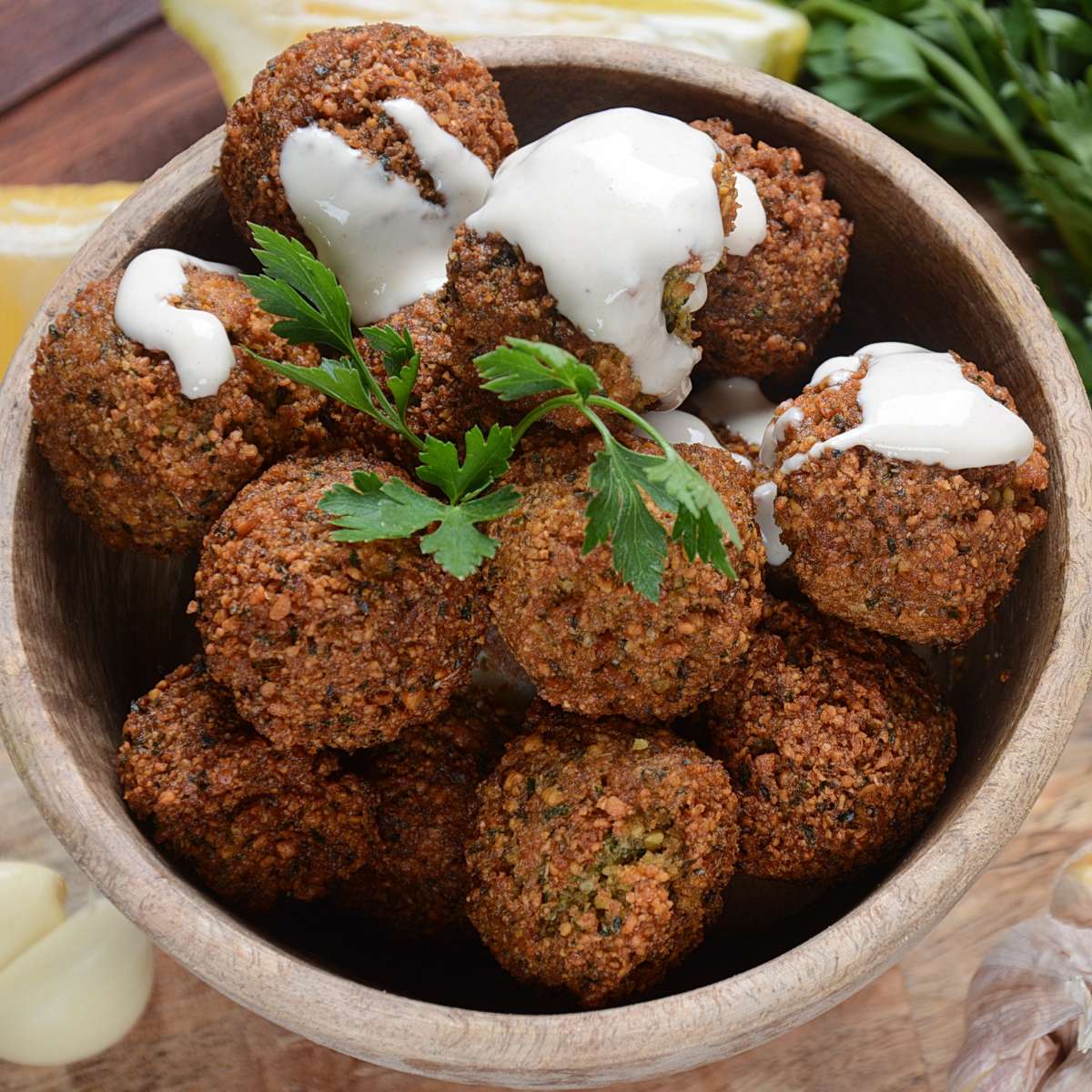What is falafel made of? Picture this: You’re strolling through a vibrant Middle Eastern market, scents of exotic spices wafting through the air, when a golden-brown delight catches your eye.
Ah, that’s right, you’ve just locked eyes with a crispy round of falafel. But, what magic goes into these savory morsels of Middle Eastern cuisine? Well, if you’ve ever dreamed of crafting your own savory falafel recipe, you’re in for a treat as we deconstruct the classic.
In this article, we’ll explore everything from the traditional legumes and herbs to modern twists that keep this dish exciting. Ready to uncover the magic behind each crispy, flavorful bite? Let’s dive in and discover what makes falafel truly special.
What Is Falafel Made Of? Exploring Its Key Ingredients
Each ingredient in falafel plays a pivotal role in creating its distinctive taste and texture. Let’s break down the essential components that make falafel the beloved dish it is today.
Chickpeas
Chickpeas are the star of the falafel show, providing a rich texture and a slightly nutty flavor that forms the backbone of the patty. These legumes are not only packed with protein but also have the perfect consistency for grinding into the hearty mixture that becomes falafel.
Fava Beans
Fava beans add an earthy depth and creamy texture to falafel. When combined with chickpeas, fava beans enhance the overall flavor profile and contribute to the signature density and moisture of the patties, making them satisfyingly chewy on the inside.
Flour
Flour serves as a crucial binding agent in falafel. It helps to hold all the ingredients together, ensuring they maintain their shape during frying. Additionally, flour contributes to the outer crispiness that makes biting into a falafel such a delightful experience.
Eggs
Eggs are another key binding component, adding moisture and helping to bind the chickpeas and fava beans together. They ensure the integrity of the falafel balls, so they don’t fall apart when cooked, providing a tender texture inside the crispy exterior.
Breadcrumbs
Breadcrumbs are used in some falafel recipes to help absorb excess moisture, ensuring the falafels are firm enough to fry without being too dry. They also add an extra layer of crunch to the falafel’s exterior, enhancing the textural contrast between the crisp outside and the soft inside.
The Flavorful Herbs and Spices in Falafel
The falafel’s irresistible charm isn’t just due to its golden exterior but to a medley of herbs and spices that bring ancient culinary traditions to life. Ready to spice up your own falafel adventures at home? Here’s a cheat sheet to whip up that magical blend:
| Herb/Spice | Flavor Profile | Quantity for 4 Servings |
|---|---|---|
| Cumin | Warm, earthy | 1 tsp |
| Coriander | Spicy, nutty | 1 tsp |
| Black Pepper | Sharp, pungent | 1/2 tsp |
| Cayenne | Hot, fiery | 1/4 tsp |
| Cardamom | Sweet, floral | Pinch |
| Parsley | Fresh, crisp | 3 tbsp (chopped) |
| Fresh Coriander | Tangy, lemony | 2 tbsp (chopped) |
| Cilantro | Bright, citrusy | Optional |
| Roasted Garlic | Sweet, caramelized | 2 cloves (minced) |
And there you have it, your coveted cheat sheet to the alchemy of herbs in falafel. Use it wisely to conjure up the most delightful falafel that will have your taste buds thrumming with joy and your kitchen smelling like a distant, spice-laden land.
Traditional Falafel Ingredients and Modern Twists
When you bite into a warm, savory falafel, you’re not just enjoying a delicious street food staple; you’re experiencing centuries of Middle Eastern culinary tradition, now infused with modern twists to meet today’s diverse dietary needs.
Classic Middle Eastern Recipes
The charm of traditional falafel cannot be overstated. With each region showcasing its prized local ingredient, this beloved dish keeps your taste buds anchored in the authentic tastes.
In Egypt, the fava bean reigns supreme in their tarwiya or t’amiya, while in Israel, chickpeas hold sway. It’s more than food; it’s a trip across the Middle East without leaving your kitchen.
Contemporary Variations and Diet Adaptations
In the modern culinary landscape, falafel has undergone innovative transformations to appeal to a broader audience, including health-conscious eaters and those with dietary restrictions. New recipes feature creative additions like sweet apricots or agave for a unique twist, and healthier, gluten-free options that are baked instead of fried.
The following table outlines the evolution of falafel ingredients, showcasing traditional components alongside their modern adaptations and the dietary considerations they address:
| Traditional Ingredient | Modern Adaptation | Dietary Consideration |
|---|---|---|
| Fava Beans | Quinoa | Gluten-Free |
| Chickpeas | Edamame | Low-Carb |
| Breadcrumbs | Chickpea Flour | Gluten-Free |
| Onions and Garlic | Caramelized Leeks | Low-FODMAP |
Preparing and Cooking Falafel: A Step-by-Step Guide
Dive into the delicious world of falafel with this straightforward guide that guarantees mouthwatering results every time you cook. Here’s how to master falafel from scratch:
- Soak the Chickpeas: Begin by soaking dry chickpeas overnight in plenty of water. This is crucial for softening the chickpeas and making them easier to blend. For a pro tip, add a little baking soda to the soaking water to enhance softening.
- Blend Your Ingredients: Drain the chickpeas and blend them with fresh herbs like parsley and cilantro, along with garlic, onion, and your chosen spices. Achieve a coarse mixture that holds together when pressed.
- Shape the Falafel: Take spoonfuls of the mixture and form them into small patties or balls. This size and shape allow for even cooking whether you’re baking or frying.
- Choose Your Cooking Method:
- Frying: Heat a generous amount of oil in a deep pan and fry the falafel balls until golden brown. This method gives you crispy, classic falafel.
- Baking: For a healthier option, place the falafel balls on a greased baking sheet, brush them with oil, and bake in a preheated oven until they are crisp and browned.
- Serve Hot: Enjoy your falafel hot from the fryer or oven. They’re perfect stuffed in pita bread with veggies and tahini sauce or served on a bed of greens for a satisfying meal.

With these steps, you’ll not only understand the basics of making falafel but also enjoy the process of bringing this beloved Middle Eastern dish to life in your own kitchen. Whether fried or baked, falafel is a versatile and delicious choice that’s sure to impress.
Expert Tips for Making Falafel at Home
Embarking on the quest to perfect your homemade falafel can be thrilling, and truly, nothing beats the satisfaction of savoring those crispy morsels straight from your own kitchen. Here are some tips to help you master homemade falafel:
- Start with Dry Chickpeas: Skip the canned chickpeas. For the best texture and flavor, use dry chickpeas that you’ve soaked overnight. This will help achieve that ideal crispy outside and soft inside.
- Choose the Right Oil: For frying falafel, use oils with a high smoke point like avocado, grapeseed, or canola. These oils ensure your falafel gets crispy without absorbing too much oil.
- Heat the Oil Properly: Make sure your oil is hot enough before you start frying. This prevents the falafel from soaking up too much oil and becoming soggy.
- Alternative Cooking Methods: If you’re looking for a healthier option, consider baking or air-frying your falafel. These methods reduce the amount of oil used and still deliver a crispy finish.
- Proper Binding: To keep your falafel from falling apart during cooking, make sure your mixture is finely ground and well combined. If it’s too dry, add a little water; if too wet, a bit more flour.
With these tips, you can whip up a batch of falafel that is perfectly crispy on the outside and deliciously soft on the inside, right from the comfort of your own kitchen. Whether you’re frying, baking, or air-frying, each method brings out a unique texture and flavor in your falafel.
Falafel Serving Styles: From Pitas to Platters
Falafel’s versatility makes it a standout dish, easily adapting from simple sandwiches to elaborate platters. Here are some popular ways to serve falafel, each offering a unique taste experience:
- Pita Sandwiches: A classic favorite, falafel balls are stuffed into warm, fluffy pita bread along with crisp lettuce, juicy tomatoes, and drizzled with creamy tahini sauce. This popular Middle Eastern street food is both satisfying and portable. Don’t have tahini on hand? No worries! Check out our guide on the Top Tahini Substitutes to find the perfect alternative for your recipes.
- Mezze Platters: For a more communal dining experience, serve falafel as part of a mezze platter. Combine it with a variety of dips like hummus and baba ghanoush, pickled vegetables, fresh salads, and warm bread. It’s perfect for sharing and allows everyone to enjoy a little bit of everything.
- Falafel Salads: Crumble falafel over a bed of greens for a hearty salad. Add tomatoes, cucumbers, and a lemony dressing for a refreshing meal that’s both filling and nutritious.
- Falafel Burgers: Swap out traditional meat patties for falafel in your next burger. Serve on a whole-grain bun with lettuce, tomato, and a slice of onion. Add a dollop of tzatziki sauce or a smear of fresh guacamole for extra flavor.
- Build-Your-Own Falafel Bar: Set up a DIY falafel bar at your next gathering. Provide bowls of falafel, various toppings, and sauces, and let guests assemble their own creations. It’s a fun and interactive way to enjoy falafel and explore different flavor combinations.
Whether you’re a traditionalist at heart or a culinary adventurer, the diverse falafel serving suggestions offer something for each palate. Go ahead, give these ideas a spin, and who knows? You might just find yourself wrapped in a new falafel favorite!
Related Article: Curious about what goes well with falafel? Check out our articles on “Is Tahini Vegan? What is it Made Of?” and “What is Hummus Made Of?” to learn more about these ideal dips that enhance this beloved dish.
Conclusion
As our culinary journey through the components of falafel comes to a close, we hope you’ve gained a deeper appreciation for this simple yet profound dish. From the humble chickpea to the rich array of spices and herbs that elevate its flavor, falafel is more than just food—it’s a cultural icon that spans continents.
Whether served in a pita, on a platter, or as a snack, each bite is a testament to the enduring appeal of Middle Eastern cuisine. Now armed with this knowledge, why not try your hand at making falafel at home? Embrace the joy of cooking and let these flavors transport you to far-off lands, bite by delicious bite.
FAQ
Is falafel always vegan?
Traditional falafel is vegan, as it doesn’t contain any animal products, focusing instead on beans, herbs, and spices.
Can falafel be made gluten-free?
Yes, falafel can easily be made gluten-free by ensuring that any added binders like flour are gluten-free alternatives such as chickpea flour.
What are some common spices used in falafel?
Common spices include cumin, coriander, garlic, and sometimes cardamom or black pepper, which add depth and flavor to the falafel.
What makes a falafel ball a nutritional powerhouse?
Besides being high-fibre food, falafel nutritional value wins the lottery with proteins, vital nutrients, and its ability to befriend your blood lipid levels, keeping them in check for a healthy heart.
What’s the best way to ensure my homemade falafel isn’t soggy?
If you want that perfect falafel, soaking chickpeas is critical. Get this step right, and you’re on your way to a crispy, golden-brown future. Whether you’re frying or baking, make sure your oil or oven is hot and ready for action!




